Flexibility-Based Reserve Scheduling of Pumped Hydroelectric Energy Storage in Korea
Abstract
:1. Introduction
2. Flexibility Index: Ramping Capability Shortage Expectation
3. Reserve Scheduling for Pumped Hydroelectric Storage
3.1. PHES Energy Scheduling
3.2. PHES Reserve Scheduling
3.2.1. Uniform Allocation Method
- A 24 h load profile for every month is calculated by averaging load values for every hour for every month, except for weekends and holidays.
- For every month, the heavy-load duration corresponds to the period when the hourly load is greater than a threshold value, here, this is determined as an average load value.
- The average value of the heavy-load duration for each season is applied to the PHES supply period.
3.2.2. The Proposed Method
- A 24 h load profile for every month is calculated by averaging load values for every hour of every month, except for weekends and holidays; this is identical to the uniform allocation method.
- For every month, the high-ramping duration corresponds to the period when the RSPt is greater than a threshold value; here, this is determined as an average RSPt value.
- The average high-ramping duration value for each season is applied to the PHES supply period.
4. Case Study
4.1. Basic Information
4.2. Result for the Peak-Load Day in 2016
4.3. Result for the Peak-Load Day in 2029
5. Conclusions
Acknowledgments
Author Contributions
Conflicts of Interest
Nomenclature
| Ai,t | Random variable representing availability of unit i at time t (1 if available, 0 otherwise) |
| c | Element of Ct−Δt |
| Ct−Δt | Set of combination of Ai,t−Δt when Oi,t−Δt is non-zero for all i |
| e | Element of Et−Δt |
| Et−Δt | Set of NLFEt |
| EPi | PHES i’s total energy at a given water level |
| FNLt | Forecast net load at time t |
| i | Index of generating unit |
| I | Set of generating unit |
| LFEt | Random variable representing load forecast error at time t |
| NLFEt | Random variable representing net load forecast error at time t |
| Oi,t | Value representing whether unit i is on-line at time t (1 if online, 0 otherwise) |
| Pi,t | Generation output of unit i at time t |
| Pmax,i | Maximum generation level of unit i |
| PHESi | Pumped hydroelectric storage i |
| Probc[·] | Probability in the brackets. |
| Probc[·] | Probability of c if condition [∙] is satisfied, 0 otherwise. |
| RCPi,t | Reserve capacity of PHESi at time t |
| RCRt | Ramping capability requirement at time t |
| REP | Reserve energy of all PHESs |
| REPi | Reserve energy of PHESi |
| rri | Ramp rate of unit i |
| RSPt | Ramping capability shortage probability at time t |
| SRCt | System ramping capability at time t |
| t, t’ | Index of time |
| Ts | Length of supply period |
| Δt | Minimum time interval between operating points |
| VG | Variable generation |
| VGFEt | Random variable representing variable generation forecast error at time t |
References
- Deobooleoh Democratic Party. Presidential Election Pledge. Available online: http://theminjoo.kr/autoalbum/page/minjoo/view.html?extweb=true (accessed on 20 August 2017).
- The Ministry of Trade, Industry and Energy. The 4th New & Renewable Energy Basic Plan; MOTIE: Sejong-si, Korea, 2014.
- Lund, P.D.; Lindgren, J.; Mikkola, J.; Salpakari, J. Review of energy system flexibility measures to enable high levels of variable renewable electricity. Renew. Sustain. Energy Rev. 2015, 45, 785–807. [Google Scholar] [CrossRef]
- Pérez-Díaz, J.I.; Jiménez, J. Contribution of a pumped-storage hydropower plant to reduce the scheduling costs of an isolated power system with high wind power penetration. Energy 2016, 109, 92–104. [Google Scholar] [CrossRef]
- Ming, Z.; Kun, Z.; Daoxin, L. Overall review of pumped-hydro energy storage in China: Status quo, operation mechanism and policy barriers. Renew. Sustain. Energy Rev. 2013, 17, 35–43. [Google Scholar] [CrossRef]
- Deane, J.; McKeogh, E.; Gallachoir, B. Derivation of intertemporal targets for large pumped hydro energy storage with stochastic optimization. IEEE Trans. Power Syst. 2013, 28, 2147–2155. [Google Scholar] [CrossRef]
- Pavesi, G.; Cavazzini, G.; Ardizzon, G. Numerical analysis of the transient behaviour of a variable speed pump-turbine during a pumping power reduction scenario. Energies 2016, 9, 534. [Google Scholar] [CrossRef]
- Korea Power Exchange. The PHES Operation Strategy Considering Power System Reliability; KPX: Naju-si, Korea, 2013. [Google Scholar]
- Yao, E.; Wang, H.; Liu, L.; Xi, G. A novel constant-pressure pumped hydro combined with compressed air energy storage system. Energies 2014, 8, 154–171. [Google Scholar] [CrossRef]
- Deane, J.P.; Gallachóir, B.Ó.; McKeogh, E. Techno-economic review of existing and new pumped hydro energy storage plant. Renew. Sustain. Energy Rev. 2010, 14, 1293–1302. [Google Scholar] [CrossRef]
- Borges, C.L.; Pinto, R.J. Small hydro power plants energy availability modeling for generation reliability evaluation. IEEE Trans. Power Syst. 2008, 23, 1125–1135. [Google Scholar] [CrossRef]
- Shim, K.; Kim, S.; Lee, J.; Choi, E.; Choi, J. Detection of low-frequency oscillation using synchrophasor in wide-area rolling blackouts. Int. J. Electr. Power Energy Syst. 2014, 63, 1015–1022. [Google Scholar] [CrossRef]
- The Korean Institute of Electrical Engineers. An Investigation Report on a Rolling Blackout Accident on Sep. 15, 2011 in Korea; KIEE: Seoul, Korea, 2011. [Google Scholar]
- Organization for Cross-regional Coordination of Transmission Operator. The Electricity Supply and Demand Plan. Available online: https://www.occto.or.jp/kyoukei/teishutsu/files/kaisetu.pdf (accessed on 15 September 2017).
- Korea Power Exchange. Electricity Market. Operation Rules; KPX: Naju-si, Korea, 2017. [Google Scholar]
- The Ministry of Trade, Industry and Energy. The 7th Basic Plan on Electricity Demand and Supply; MOTIE: Sejong-si, Korea, 2015.
- Black, M.; Strbac, G. Value of bulk energy storage for managing wind power fluctuations. IEEE Trans. Energy Convers. 2007, 22, 197–205. [Google Scholar] [CrossRef]
- Borghetti, A.; D’Ambrosio, C.; Lodi, A.; Martello, S. An MILP approach for short-term hydro scheduling and unit commitment with head-dependent reservoir. IEEE Trans. Power Syst. 2008, 23, 1115–1124. [Google Scholar] [CrossRef]
- Kazempour, S.J.; Moghaddam, M.P.; Haghifam, M.; Yousefi, G. Risk-constrained dynamic self-scheduling of a pumped-storage plant in the energy and ancillary service markets. Energy Convers. Manag. 2009, 50, 1368–1375. [Google Scholar] [CrossRef]
- Varkani, A.K.; Daraeepour, A.; Monsef, H. A new self-scheduling strategy for integrated operation of wind and pumped-storage power plants in power markets. Appl. Energy 2011, 88, 5002–5012. [Google Scholar] [CrossRef]
- Pérez-Díaz, J.I.; Chazarra, M.; García-González, J.; Cavazzini, G.; Stoppato, A. Trends and challenges in the operation of pumped-storage hydropower plants. Renew. Sustain. Energy Rev. 2015, 44, 767–784. [Google Scholar] [CrossRef]
- Min, C.; Park, J.; Hur, D.; Kim, M. A risk evaluation method for ramping capability shortage in power systems. Energy 2016, 113, 1316–1324. [Google Scholar] [CrossRef]
- Wang, Q.; Hodge, B.-M. Enhancing power system operational flexibility with flexible ramping products: A review. IEEE Trans. Ind. Inf. 2016, 13, 1652–1664. [Google Scholar] [CrossRef]
- Billinton, R.; Allan, R. Reliability Evaluation of Power Systems, 2nd ed.; Springer Science & Business Media: New York, NY, USA, 2013. [Google Scholar]
- Chazarra, M.; Pérez-Díaz, J.I.; García-González, J. Deriving optimal end of day storage for pumped-storage power plants in the joint energy and reserve day-ahead scheduling. Energies 2017, 10, 813. [Google Scholar] [CrossRef]
- Korea Power Exchange. Electric Power Statistics Information System. Available online: http://epsis.kpx.or.kr/epsis/ekesStaticMain.do?cmd=001001&flag=&locale=EN (accessed on 20 August 2017).
- Chung, M.; Lee, S.G.; Park, C.; Park, H.-C.; Im, Y.-H. Development of a combined energy-demands calculator for urban building communities in Korea. Environ. Plan. B 2013, 40, 289–310. [Google Scholar] [CrossRef]
- Master’s Space. M-Core User’s Manual; MS: Anyang-si, Korea, 2016. [Google Scholar]
- Li, L. Matlab User Manual; Matlab: Natick, MA, USA, 2001. [Google Scholar]
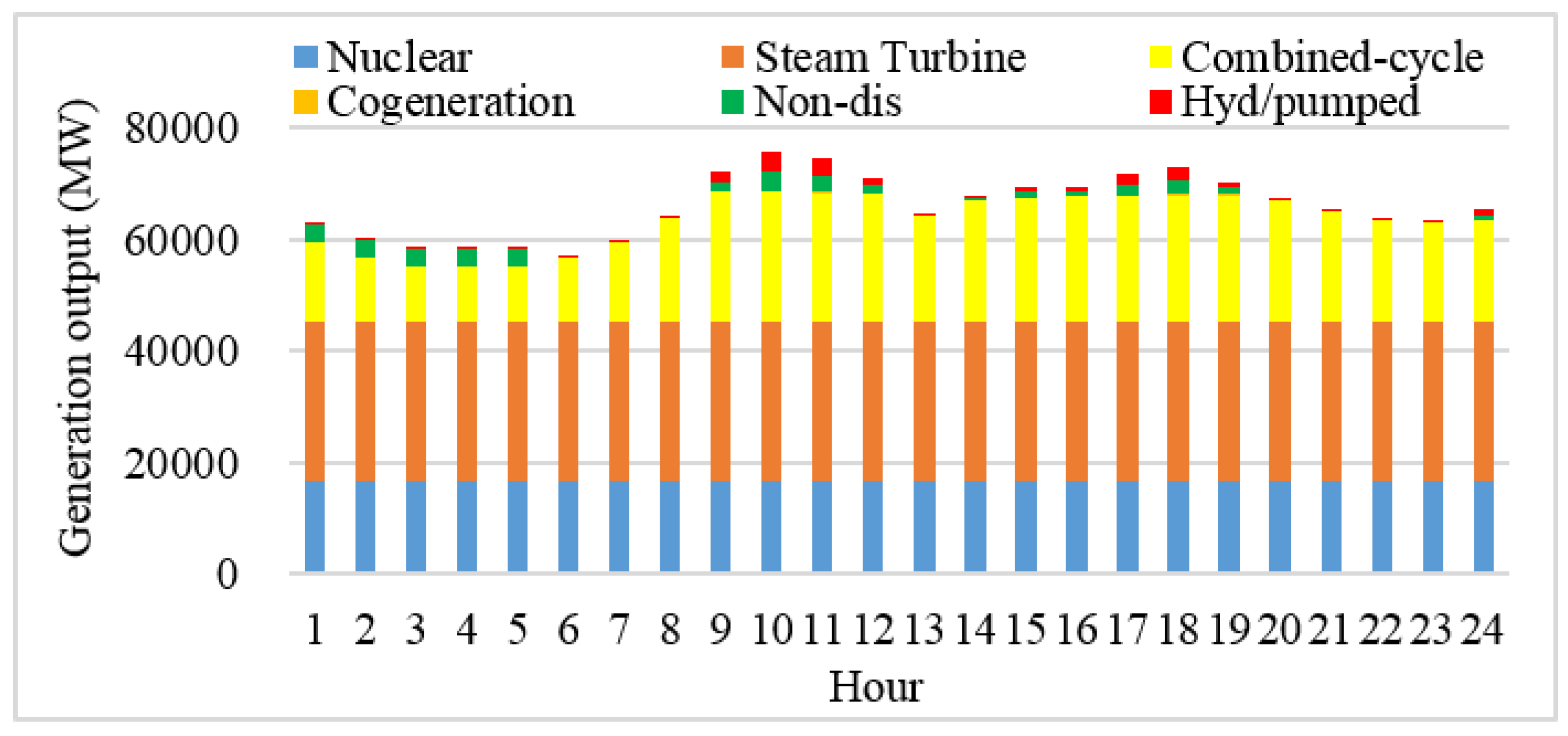

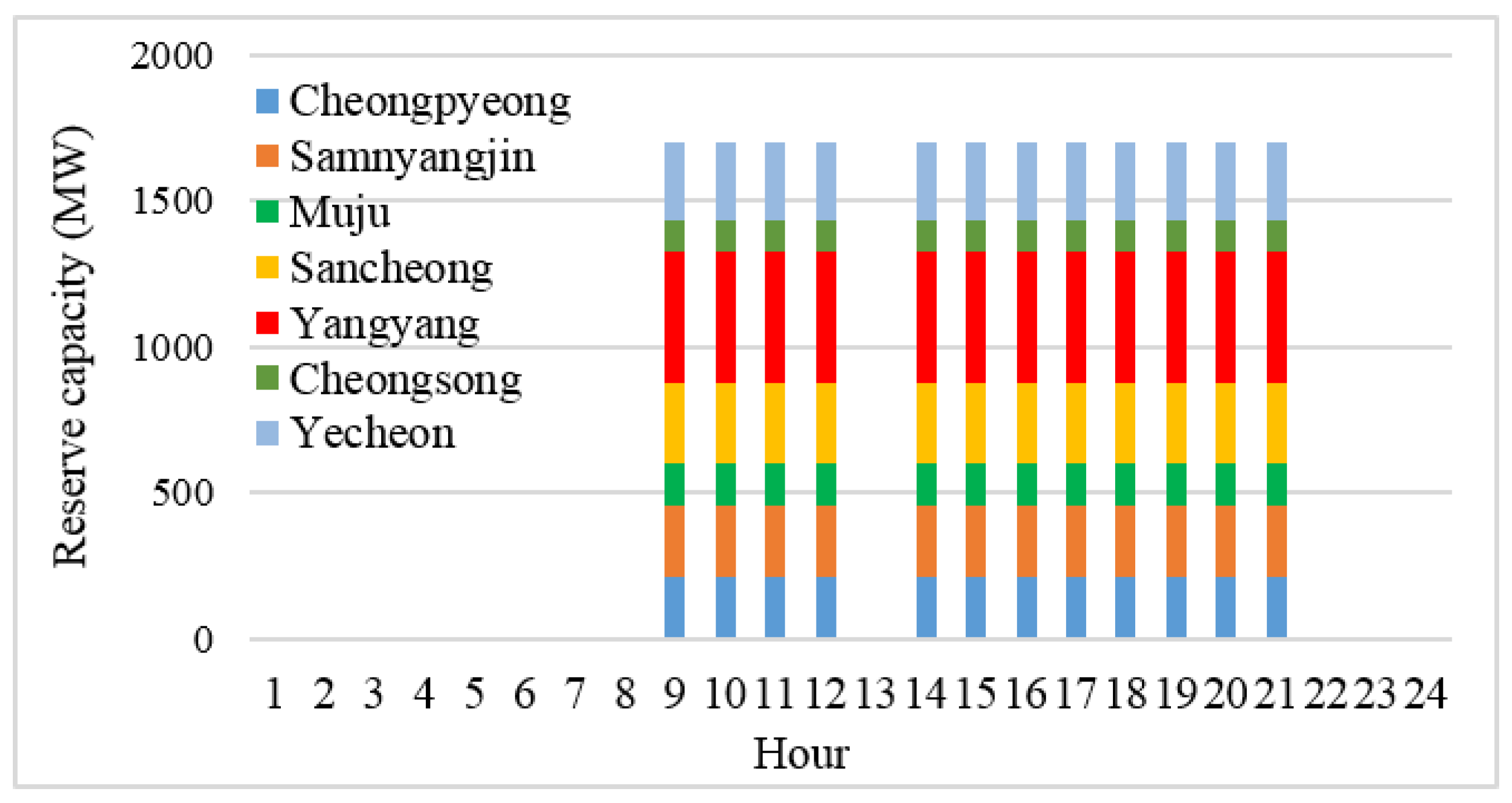
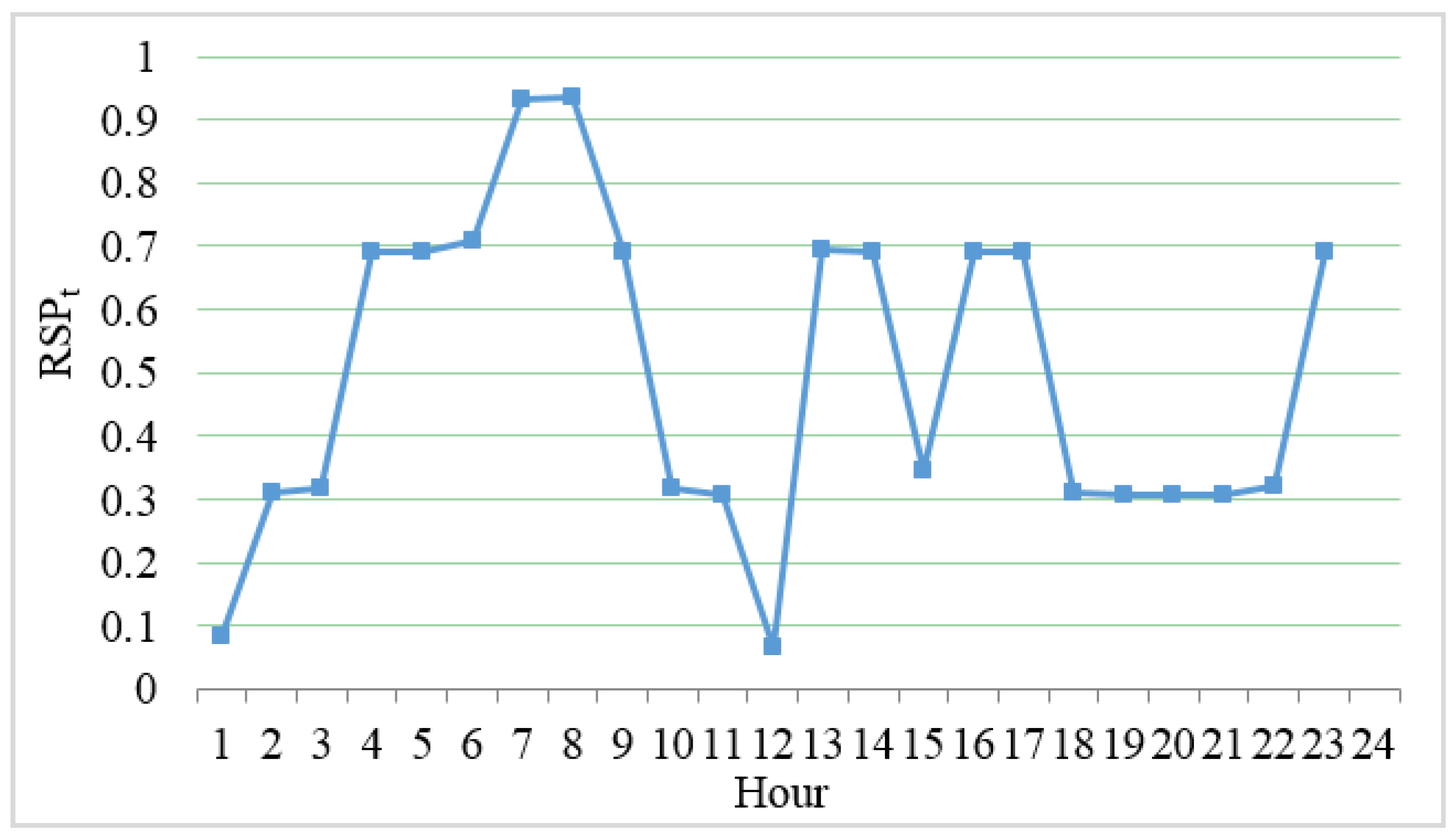
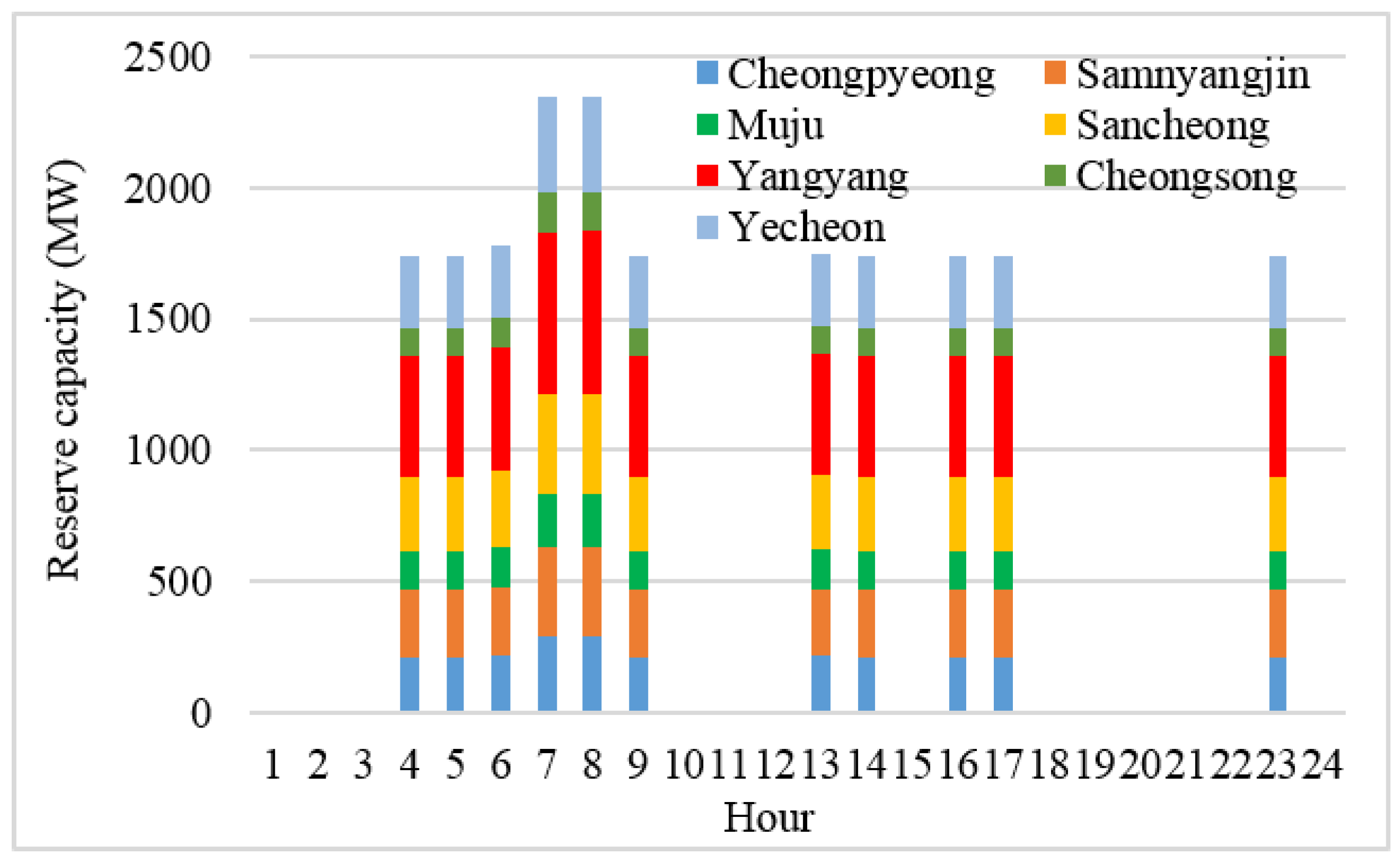
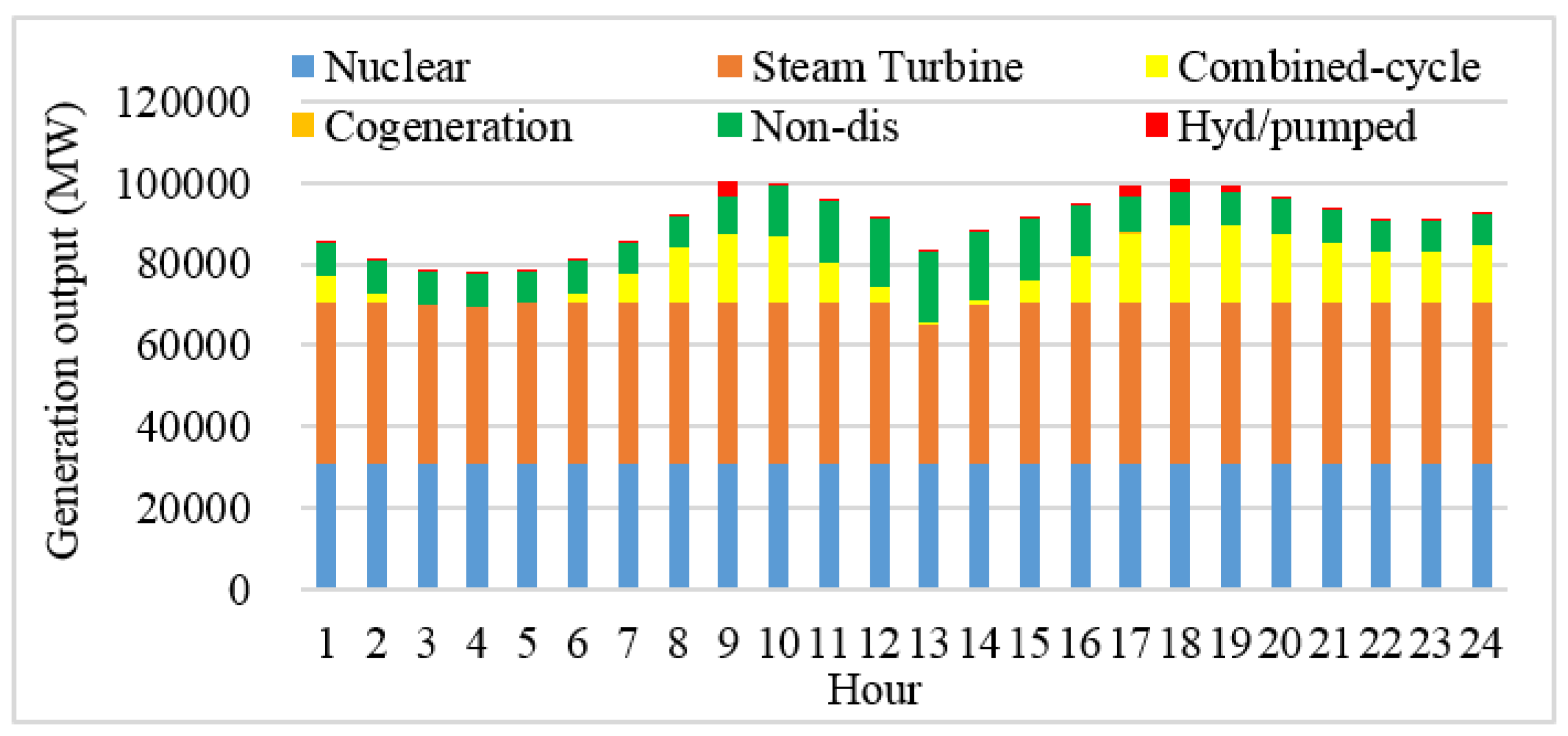
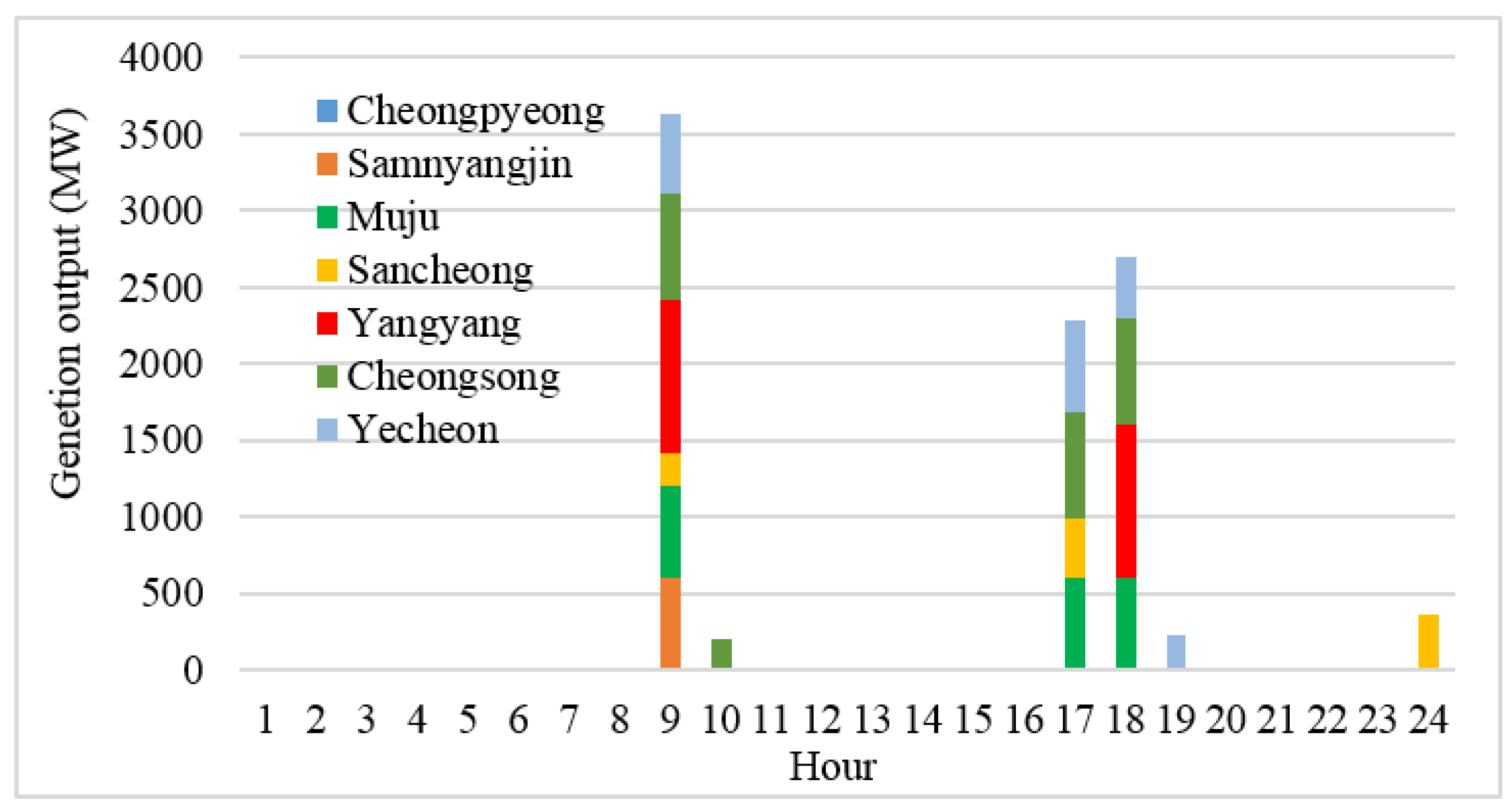

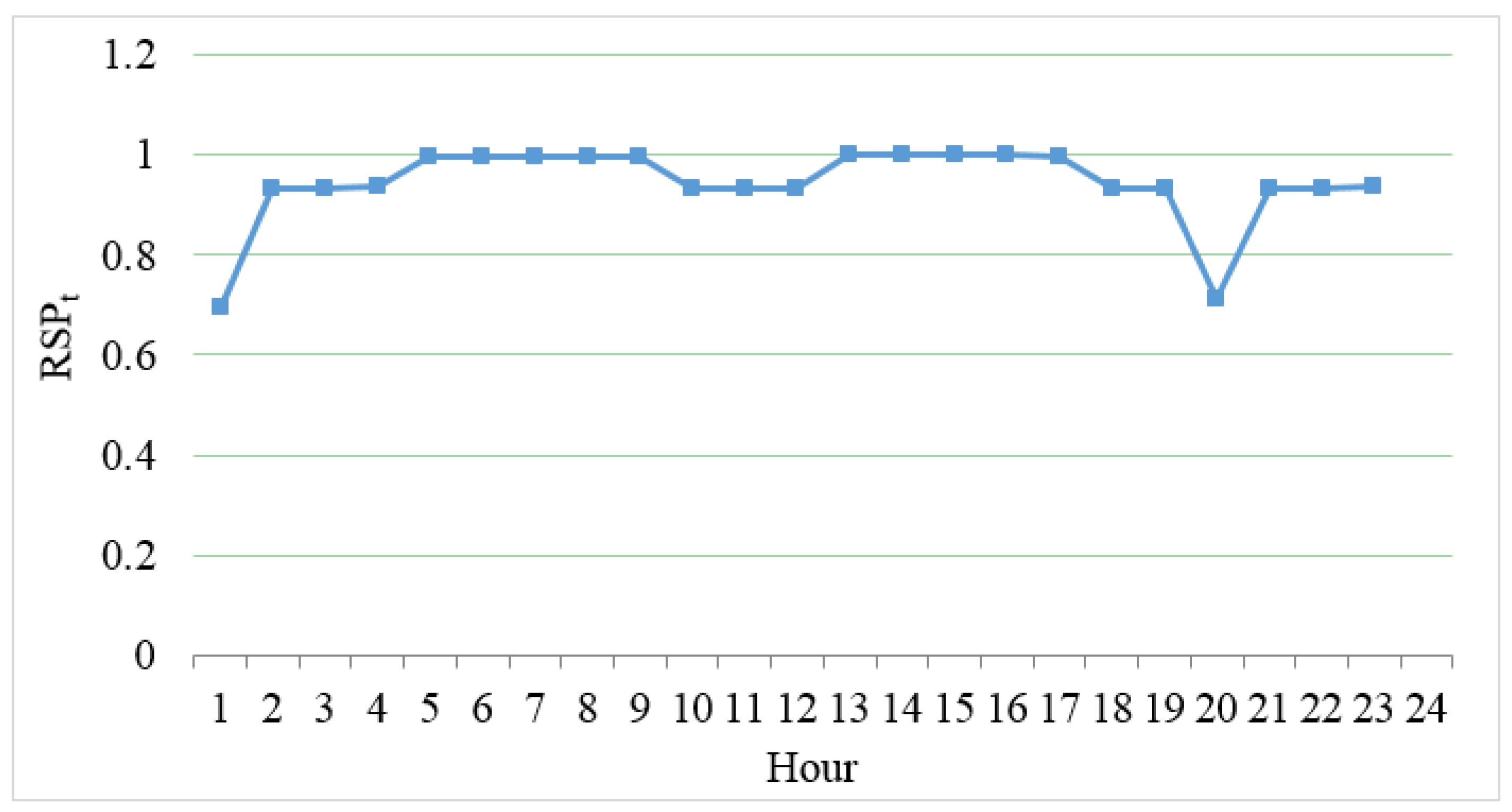

| Name | Generation Power (MW) | Energy at Full Water Level (MWh) | Energy at Minimum Water Level (MWh) | Maximum Available Energy (MWh) |
|---|---|---|---|---|
| Cheongpyeong | 200 × 2 | 2680 | 168.7 | 2511.3 |
| Samnyangjin | 360 × 2 | 3900 | 320.6 | 3579.4 |
| Muju | 300 × 2 | 4440 | 336.6 | 4103.4 |
| Sancheong | 350 × 2 | 5670 | 393.4 | 5276.6 |
| Yangyang | 260 × 4 | 8500 | 128.9 | 8371.1 |
| Cheongsong | 300 × 2 | 5100 | 360.3 | 4739.7 |
| Yecheon | 400 × 2 | 6580 | 434 | 6146.0 |
| Hour | Cheong -Pyeong | Samnyang-Jin | Muju | Sancheong | Yangyang | Cheong -Song | Yecheon |
|---|---|---|---|---|---|---|---|
| Hour 1 | 20.93 | 29.83 | 34.20 | 43.97 | 69.76 | 39.50 | 51.22 |
| Hour 2 | 20.93 | 29.83 | 34.20 | 43.97 | 69.76 | 39.50 | 51.22 |
| Hour 3 | 20.93 | 29.83 | 34.20 | 43.97 | 69.76 | 39.50 | 51.22 |
| Hour 4 | 20.93 | 29.83 | 34.20 | 43.97 | 69.76 | 39.50 | 51.22 |
| Hour 5 | 20.93 | 29.83 | 34.20 | 43.97 | 69.76 | 39.50 | 51.22 |
| Hour 6 | 20.93 | 29.83 | 34.20 | 43.97 | 69.76 | 39.50 | 51.22 |
| Hour 7 | 20.93 | 29.83 | 34.20 | 43.97 | 69.76 | 39.50 | 51.22 |
| Hour 8 | 20.93 | 29.83 | 34.20 | 43.97 | 69.76 | 39.50 | 51.22 |
| Hour 9 | 20.93 | 29.83 | 34.20 | 43.97 | 69.76 | 39.50 | 51.22 |
| Hour 10 | 20.93 | 29.83 | 34.20 | 43.97 | 69.76 | 39.50 | 51.22 |
| Hour 11 | 20.93 | 29.83 | 34.20 | 43.97 | 69.76 | 39.50 | 51.22 |
| Hour 12 | 20.93 | 29.83 | 34.20 | 43.97 | 69.76 | 39.50 | 51.22 |
| Total | 251.13 | 357.94 | 410.34 | 527.66 | 837.11 | 473.97 | 614.60 |
| t (h) | 1 | 2 | 3 | 4 | 5 | 6 | 7 | 8 | 9 | 10 | 11 | 12 |
| RSPt | 0.1 | 0.1 | 0.2 | 0.2 | 0.3 | 0.3 | 0.4 | 0.4 | 0.5 | 0.5 | 0.6 | 0.6 |
| t (h) | 13 | 14 | 15 | 16 | 17 | 18 | 19 | 20 | 21 | 22 | 23 | 23 |
| RSPt | 0.6 | 0.6 | 0.5 | 0.5 | 0.4 | 0.4 | 0.3 | 0.3 | 0.2 | 0.2 | 0.1 | 0.1 |
| Hour | Cheong -Pyeong | Samnyang -Jin | Muju | Sancheong | Yangyang | Cheong -Song | Yecheon |
|---|---|---|---|---|---|---|---|
| Hour 7 | 16.74 | 23.86 | 27.36 | 35.18 | 55.81 | 31.60 | 40.97 |
| Hour 8 | 16.74 | 23.86 | 27.36 | 35.18 | 55.81 | 31.60 | 40.97 |
| Hour 9 | 20.93 | 29.83 | 34.20 | 43.97 | 69.76 | 39.50 | 51.22 |
| Hour 10 | 20.93 | 29.83 | 34.20 | 43.97 | 69.76 | 39.50 | 51.22 |
| Hour 11 | 25.11 | 35.79 | 41.03 | 52.77 | 83.71 | 47.40 | 61.46 |
| Hour 12 | 25.11 | 35.79 | 41.03 | 52.77 | 83.71 | 47.40 | 61.46 |
| Hour 13 | 25.11 | 35.79 | 41.03 | 52.77 | 83.71 | 47.40 | 61.46 |
| Hour 14 | 25.11 | 35.79 | 41.03 | 52.77 | 83.71 | 47.40 | 61.46 |
| Hour 15 | 20.93 | 29.83 | 34.20 | 43.97 | 69.76 | 39.50 | 51.22 |
| Hour 16 | 20.93 | 29.83 | 34.20 | 43.97 | 69.76 | 39.50 | 51.22 |
| Hour 17 | 16.74 | 23.86 | 27.36 | 35.18 | 55.81 | 31.60 | 40.97 |
| Hour 18 | 16.74 | 23.86 | 27.36 | 35.18 | 55.81 | 31.60 | 40.97 |
| Total | 251.13 | 357.94 | 410.34 | 527.66 | 837.11 | 473.97 | 614.60 |
| PHES Name | EPi (MWh) | ∑Pi,t−Δt (MW) | REPi (MWh) |
|---|---|---|---|
| Cheongpyeong | 2511.3 | 0 | 2511.3 |
| Samnyangjin | 3579.4 | 600 | 2979.4 |
| Muju | 4103.4 | 2356 | 1747.4 |
| Sancheong | 5276.6 | 1968 | 3308.6 |
| Yangyang | 8371.1 | 3000 | 5371.1 |
| Cheongsong | 4739.7 | 3460 | 1279.7 |
| Yecheon | 6146.0 | 2974 | 3172.0 |
| - | - | - | REP: 20,369.5 (MWh) |
| PHES Name | EPi (MWh) | ∑Pi,t−Δt (MW) | REPi (MWh) |
|---|---|---|---|
| Cheongpyeong | 2511.3 | 0 | 2511.3 |
| Samnyangjin | 3579.4 | 600 | 2979.4 |
| Muju | 4103.4 | 1800 | 2303.4 |
| Sancheong | 5276.6 | 959.4 | 4317.2 |
| Yangyang | 8371.1 | 2000 | 6371.1 |
| Cheongsong | 4739.7 | 2300 | 2439.7 |
| Yecheon | 6146.0 | 1735.4 | 4410.6 |
| - | - | - | REP: 25,332.8 (MWh) |
© 2017 by the authors. Licensee MDPI, Basel, Switzerland. This article is an open access article distributed under the terms and conditions of the Creative Commons Attribution (CC BY) license (http://creativecommons.org/licenses/by/4.0/).
Share and Cite
Min, C.-G.; Kim, M.-K. Flexibility-Based Reserve Scheduling of Pumped Hydroelectric Energy Storage in Korea. Energies 2017, 10, 1478. https://doi.org/10.3390/en10101478
Min C-G, Kim M-K. Flexibility-Based Reserve Scheduling of Pumped Hydroelectric Energy Storage in Korea. Energies. 2017; 10(10):1478. https://doi.org/10.3390/en10101478
Chicago/Turabian StyleMin, Chang-Gi, and Mun-Kyeom Kim. 2017. "Flexibility-Based Reserve Scheduling of Pumped Hydroelectric Energy Storage in Korea" Energies 10, no. 10: 1478. https://doi.org/10.3390/en10101478
APA StyleMin, C.-G., & Kim, M.-K. (2017). Flexibility-Based Reserve Scheduling of Pumped Hydroelectric Energy Storage in Korea. Energies, 10(10), 1478. https://doi.org/10.3390/en10101478





